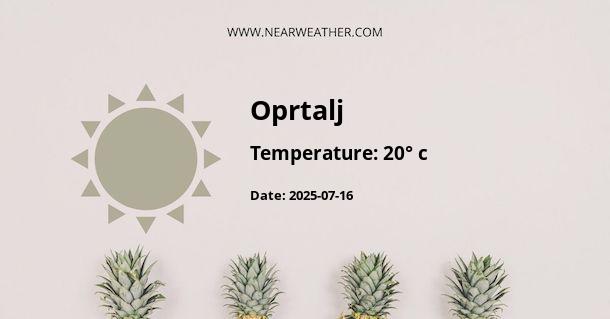Overview of Oprtalj and its Climate
Oprtalj, located in the Istrian Peninsula of Croatia, is known for its picturesque landscapes and Mediterranean climate. This enchanting town, often referred to by its Italian name Portole, is perched on a hilltop offering sweeping views of the Mirna River Valley and the surrounding rolling hills dotted with vineyards and olive groves. The climate in Oprtalj plays a significant role in its appeal to both residents and visitors, characterized by mild, rainy winters and warm, dry summers.
Understanding the Mediterranean Climate
The Mediterranean climate, classified under the Köppen climate classification as 'Csa,' features distinct seasonal changes. Here's a closer look at this climate type:
- Mild Winters: Winters are typically mild, with temperatures rarely dropping below freezing. Precipitation is more frequent during this season, offering a respite for the local flora.
- Warm Summers: Summers are warm to hot and dry, creating the perfect environment for enjoying the outdoors and the region's many cultural festivals.
- Transition Seasons: Spring and autumn act as transition periods, showcasing a gradual shift in temperatures and a balance of precipitation that contributes to the area's lush vegetation.
Oprtalj's Year-Round Weather Patterns
For a more detailed understanding of Oprtalj's weather, let us break down the patterns observed over the year through historical data and meteorological research:
Winter (December - February)
In Oprtalj, winters are cool with an average temperature ranging from 5°C to 9°C. Precipitation peaks during these months, contributing to the area's green winters that set the stage for vibrant springs.
Spring (March - May)
Spring brings an increase in temperatures, averaging from 10°C to 18°C, as well as a mild reduction in rainfall. The season is characterized by the blooming of wildflowers and the vitality of new leaves on the trees.
Summer (June - August)
Summer is the dry and tourist-friendly season, with temperatures often climbing above 25°C. Rainfall is sporadic, typically presenting in the form of brief, intense thunderstorms that punctuate the otherwise clear skies.
Autumn (September - November)
During autumn, temperatures gradually decrease from warm to mild, averaging from 14°C to 21°C. The precipitation begins to rise again, nurturing the region's famous truffles and olives and painting the landscape in rich hues of red and gold.
Oprtalj Annual Weather Statistics
| Month | Average High (°C) | Average Low (°C) | Rainfall (mm) |
|---|---|---|---|
| January | 6 | 1 | 78 |
| February | 7 | 1 | 65 |
| March | 11 | 4 | 70 |
| April | 15 | 8 | 74 |
| May | 21 | 12 | 68 |
| June | 25 | 16 | 56 |
| July | 28 | 18 | 49 |
| August | 28 | 18 | 63 |
| September | 24 | 15 | 85 |
| October | 18 | 11 | 107 |
| November | 12 | 7 | 115 |
| December | 8 | 3 | 97 |
Climatic Influences affecting Oprtalj
The weather in Oprtalj, as with any region, is influenced by several geographical and atmospheric factors:
- Proximity to the Adriatic Sea: The sea moderates temperatures in Oprtalj, ensuring the winters are milder and the summers cooler than those experienced inland.
- Altitude: Situated on a hilltop, Oprtalj is subject to cooler temperatures than coastal towns at sea level.
- Topography: The terrain of the Istrian Peninsula, with its valleys and slopes, can influence wind patterns and precipitation distribution.
Weather Forecasting and Predictive Modeling
Meteorologists and climatologists use various tools and models to forecast the weather and predict climate trends in Oprtalj. Some of these include:
- Numerical Weather Prediction (NWP) Models: These are computer simulations that take into account atmospheric variables to predict future weather conditions.
- Remote Sensing: Using satellites and radar, meteorologists can gather data on cloud cover, land and sea temperatures, and weather systems to make accurate predictions.
- Historical Climate Data: Long-term trends and records also inform climate predictions and identify potential shifts in weather patterns due to global factors like climate change.
Oprtalj's Weather and Its Impact on Lifestyle and Economy
The climate in Oprtalj substantially influences the local lifestyle and economy. Agriculture, particularly olive oil and wine production, thrives in the mild climate. Tourism also peaks during the summer months, with visitors flocking to the region for its natural beauty and cultural events. Meanwhile, cooler temperatures in winter provide a quiet, introspective period that shapes the social fabric of the local community.
Preparing for Weather in Oprtalj
Visitors and residents alike should prepare for Oprtalj's weather to make the most of the region's offerings:
- Winter: Carry warm clothing and waterproof gear to stay comfortable amidst cooler temperatures and rain.
- Summer: Lightweight clothing, sunscreen, and ample hydration are key in the hot, dry summer months.
- Spring/Autumn: Layering is essential in these transitional seasons, as temperatures can fluctuate.
Conclusion
Oprtalj's climate is a fundamental aspect of its charm and appeal. Understanding the nuances of its weather patterns is essential for anyone looking to visit or immerse themselves in the rhythms of life in this stunning region of Croatia.
A - Oprtalj's Latitude is 45.381672 & Longitude is 13.826110.
A - Weather in Oprtalj is 6° today.
A - Climate Conditions in Oprtalj shows scattered clouds today.
A - Humidity in Oprtalj is 87% today.
A - Wind speed in Oprtalj is 11.12 km/h, flowing at 120° wind direction. today.
